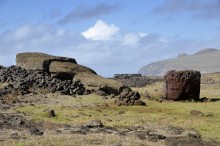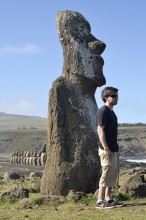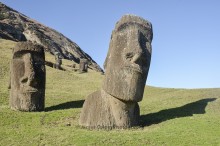Day 17 - Isla De Pascua In A Day
…or at least all of the major Moai-based sites. Today was probably the best day of the trip so far, and it’s safe to say I’ve now seen enough Moai to last a very long time.
The day started with by far the easiest car hire I have ever encountered, and perhaps ever will. Before I went to bed last night I asked reception who the best company to use is. They said don’t worry we will sort it out and asked what time I wanted the car. I said 8/9ish, and like magic a car was on the hotel’s driveway for me when I enquired just before 9 this morning. The key was handed to me by the receptionist, and I asked if she wanted a credit card or driving license. She said don’t worry about it! I’m still not quite sure if the car I drove around all day was a proper rental, or just a friend of the hotel’s car, but either way I have my international drivers permit so I wasn’t too concerned about getting all the rental documentation (and I am pleased to report the car has now been returned without a scratch).
With my mp3 player plugged into the auxiliary output, I was ready to set off on my self-guided tour. I should say now that it was only possible thanks to reception lending me a signed copy of the definitive Easter Island guidebook, ‘A Companion to Easter Island’ by James Grant Peterkin. Driving on the island was very easy, with drivers behaving a lot better than on the mainland, and near-deserted roads outside of Hanga Roa. By the end of the day, I more or less knew my way around the entire island; it really is that small.
My first stop of the day was the island’s two beaches: Anakena and Ovahe. Anakena is a primary destination for tour buses, and the only place on the island outside of Hanga Roa with a cafe and a shop. Ovahe on the other hand, is more of a small cove, and since it can only be found by taking an un-signposted dirt track, it is more of a secret swimming destination for the locals. It is quickly obvious why Anakena is the one all the tourists go to: it is a typical tropical beach with white sand, gentle waves which stay at a pleasant 18-22 degrees year round, and palm trees imported from Tahiti (all original palms were destroyed in creating the Moai). Add to this the cows and horses which roam freely around and you already have quite a unique environment. However, that’s before you consider the Ahu featuring the five most detailed Moai on the island, the Ahu featuring the first re-erected Moai, and the Moai lying on the sand. It was hard to do it justice with photos.
The beaches had taken up most of the morning, so I decided to head back to town for lunch, and to quickly catch the 4x100m relay. While in town I noticed the Moai in the main plaza, which is the only one on the island facing out to sea – apparently the only reason for this is human error while it was erected! With lunch complete, I headed back to the other side of the island in order to visit Ahu Tongariki and the quarry at Rano Raraku. On the way I first stopped at Te Pito Kura, which features the largest Moai ever erected on a platform (though it is sadly now face down in the dirt), and the navel of the world stone, which is said to have been brought to the island by its first king, Hotu Matu’a.
Just a short drive further, and I got my first glimpse of Ahu Tongariki in the distance. This is one of the most striking sights on the entire island, with 15 Moai erected on the largest ceremonial platform in the whole of Polynesia. The Moai are of varying condition, and only one has had its topknot (the red hair/hat I referred to yesterday) replaced. The other topknots are lying on the ground next to the platform. The interesting thing about this Ahu is that a Japanese company paid for it to be restored due to Easter Island being very popular over there. This process would have been much simpler had it not been for a tsunami in 1960 washing some of the Moai tens of metres from their original falling spots. Once the restoration was complete, a 16th Moai (which now stands close to the Ahu) was sent to Japan for exhibition as a thank you – it is now known as the ‘Travelling Moai’.
I had decided to save the best until last, with my final major stop of the day being at the place where it all began: the quarry at Rano Raraku. The quarry is basically an extinct volcano, with a crater lake in the middle, and the Moai made from the volcanic rock. Moai were carved both inside and outside the crater, though the ones in the crater had a much longer journey to make. As I approached the quarry, I could already see dozens of abandoned Moai sticking out on the mountainside. On arrival, I decided to first head up to the crater where I got my most incredible views yet. On one side I could see the majority of the island, and on the other I could see the crater lake. Having never been inside a volcano before, I had to stop to take it all in, including numerous Moai dotted around on the other side.
After the crater, I visited the main quarry on the outside slope of the volcano. There are almost 400 Moai here, in various stages of carving and movement. Each Moai is exactly as it was when abandoned around 200 years ago, and to this day no one really knows why the sculptors decided to simply cease what they were doing one day. However, when they did cease, the earth they had displaced slowly moved back down the mountain, covering the Moai in transit, so today you can mostly only see the heads sticking out of the dirt. It’s a truly fascinating sight, and highlights included the largest Moai ever carved (it was huge – I couldn’t quite believe it), and staring up at the mountain to make out faces and bodies in the early stages of creation. It is truly an eerie sight to think these people spent their entire lives carving the Moai, only to abandon them in what has now become a Moai graveyard.
On my drive back I was feeling all Moai-ed out, though still took the time to stop at a couple more sights. It’s worth noting the large cow and horse population on the island. Despite all being owned by various islanders, the populations are essentially wild, and they roam around the roads freely (I even saw a herd of cows migrating across a volcano at one point). The waves were also of note, given they were the largest I’ve ever seen, and what I would describe as typical ‘surfer’ waves, with huge breaks at least 2-3m high.
This evening I went out for dinner in Hanga Roa and took a drive inland, away from all the light pollution, in order to appreciate the clear night sky. Down here the sky is so clear you can make out the Milky Way as a band of light across the sky – quite a sight!
Photos of the day: it was hard not to be snap-happy with all the Moai around, so here are a selection of the 100 photos I took today. The Ahu at Anakena, the fallen Moai at Te Pito Kura, me attempting to imitate the travelling Moai with Ahu Tongariki in the background, just some of the scores of Moai at Raro Raraku.





Comments
Sounds an absolutely
Sounds an absolutely wonderful experience for you. I'm so pleased you went!
The Maois will miss you xxx
I never save the best for
I never save the best for last in case I run out of time.
Sounds like you made the right decision in spending your pocket money on a flight over.
Add new comment